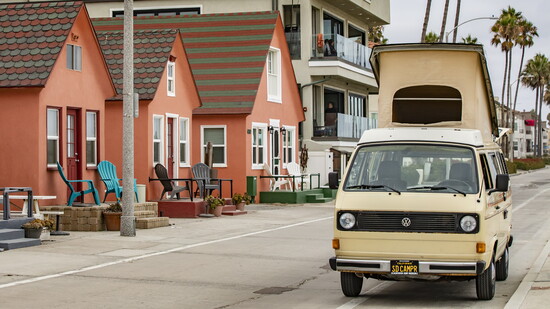There’s a particular kind of beauty that only time can shape—worn leather, sun-faded paint, the soft click of a well-used gearshift. Beauty that has nothing to do with polish and everything to do with presence. It is more than a mode of transport—it is a vessel of memory, the kind that stores sunrises, surf wax, faded paper maps, and laughter carried on warm coastal winds.
This 1982 Volkswagen Westfalia, purchased in 2014 from its original owner in the Mission Hills neighborhood of Los Angeles, stands as a well-preserved testament to the golden era of road-tripping freedom. As the final model year of the air-cooled Vanagons, this Westy represents the end of an engineering lineage that dates back to the original VW Type 2—making it a sought-after vehicle among enthusiasts and purists alike. It is the last of its kind—the final chapter of the air-cooled era—and it wears that legacy with subtle dignity.
Beloved by collectors, it remains one of the most recognizable silhouettes in automotive history. Square-bodied, upright, and endlessly optimistic in design, it embodies a spirit of movement that has always been more about the journey than the speed.
This is not a van built for urgency. It was never meant to race—it was made to roam.
Powered by a 2.0-liter air-cooled flat-four engine, paired with a 4-speed manual transmission, this van offers a hands-on, analog driving experience that feels delightfully connected to the road. There’s no electronic interference here—just gears, pedals, and the low, rhythmic hum of a boxer engine doing what it was designed to do: take you somewhere slowly and memorably, and entirely on your own terms.
Driving this van is a conversation with the road itself, each mile a thread in a larger story.
The original Westfalia camper package remains intact and gently aged. The canvas pop-top, compact kitchenette, and fold-flat rear bench were designed with German ingenuity but lend themselves perfectly to California dreaming. Two burners, a sink, and a cold-box encourage simple meals and long mornings.
There is no luxury here, not in the traditional sense. But there is comfort in simplicity, and an elegance in restraint. The design is intuitive, efficient, and deeply human.
Storage is tucked into every corner—beneath the bench seat, behind the cabinets, overhead. Every space has been considered, used, and appreciated. The rear bench folds down into a bed with just enough room to stretch out beneath the stars. It’s a van that encourages you to stay awhile.
The interior retains its original brown plaid upholstery—an iconic pattern for early ’80s Westfalias—and most of the cabinetry and trim show the kind of honest wear that speaks to decades of careful use rather than abuse. And the pastel white exterior, slightly weathered but dignified, continues to draw waves and nods from those who remember—and those who wish they did.
There’s no power steering. No air conditioning. No touchscreen navigation or digital comfort settings. It’s about arriving, gradually, with all your senses intact.
Sunlight tracing the edge of the windshield.
In this van, you’re not commuting. You’re traveling—with intention, with presence, and with a kind of quiet delight.
Windows roll down by hand. Maps fold into gloveboxes. You watch the landscape not through a filtered lens, but through wide glass panes as it rolls slowly by. Every curve in the road is something to feel. Every stop a chance to linger.
And that’s perhaps its greatest gift. In a culture that values acceleration, this van has only ever offered an invitation to slow down.
In an era dominated by van-life influencers and high-tech campers equipped with solar panels and Wi-Fi boosters, this 1982 Westfalia moves at its own pace. It doesn’t chase the algorithm. It doesn’t ask to be posted. It does not perform for the camera, nor does it chase approval. Its magic lies in the unspoken—its rhythm, its resilience, and its enduring appeal. It is not retro for the sake of style. It simply is what it has always been: functional, charming, and unbothered by the passing of time.
And so it keeps rolling—up winding canyon roads, down the coast, through tall pines and golden hills—still humming, still carrying its stories. Parked oceanside beneath a setting sun or tucked under a grove of eucalyptus, it never needs to say much.
A van like this does not just take you places.
It reminds you why you wanted to go in the first place.
"Our 1982 Westfalia has been more than just a camper van — it’s been a time capsule of our family’s early years. We got it when the kids were still little, all sandy feet and sun-kissed cheeks, piling in after long days at the beach. "
"It’s carried us up and down the coast, from tucked-away campgrounds to empty surf breaks, always ready with a warm bed and a place to cook up something simple after the sun went down."
"It’s more than a van; it’s part of our story."
